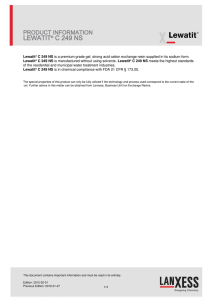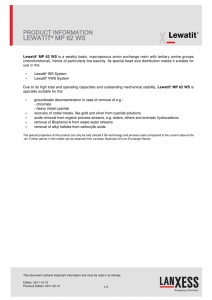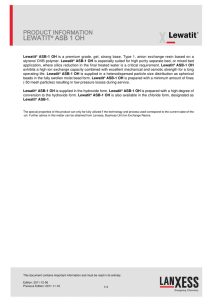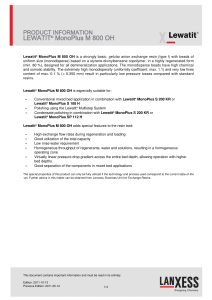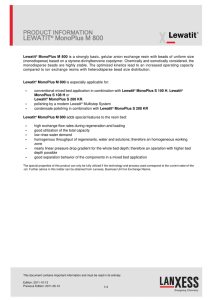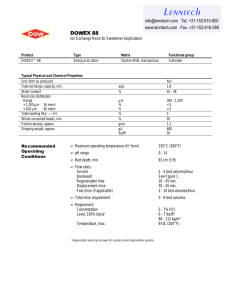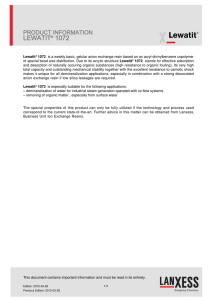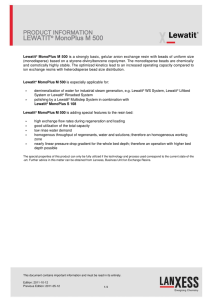S 1468 LEWATIT Product Information
advertisement
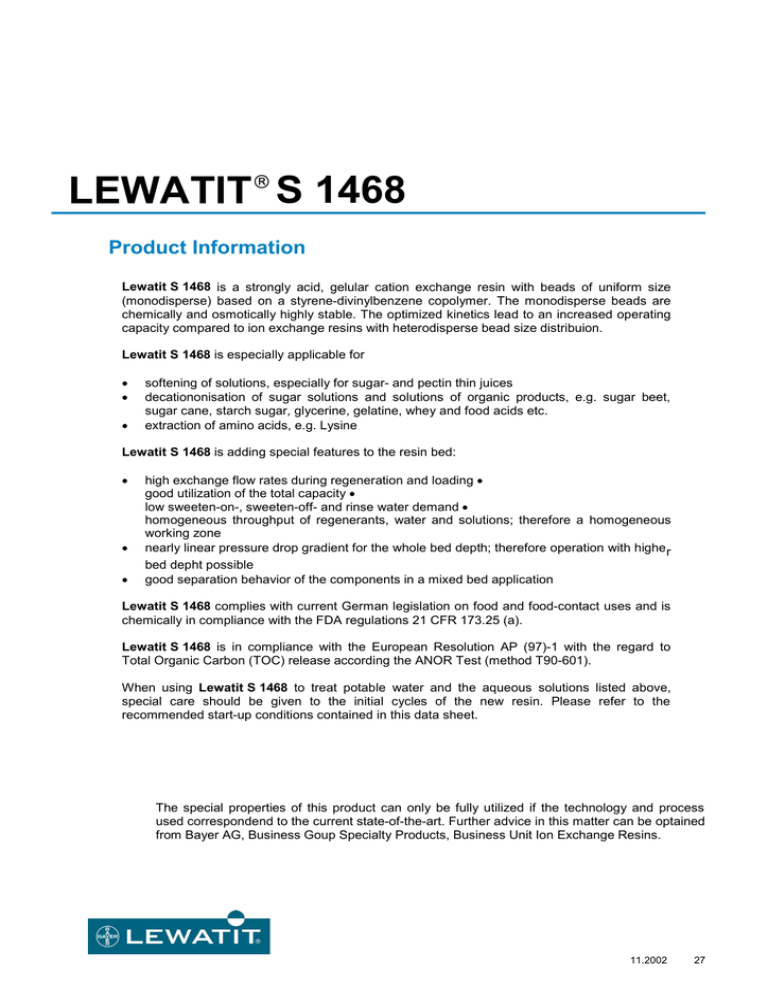
LEWATIT S 1468 Product Information Lewatit S 1468 is a strongly acid, gelular cation exchange resin with beads of uniform size (monodisperse) based on a styrene-divinylbenzene copolymer. The monodisperse beads are chemically and osmotically highly stable. The optimized kinetics lead to an increased operating capacity compared to ion exchange resins with heterodisperse bead size distribuion. Lewatit S 1468 is especially applicable for • • • softening of solutions, especially for sugar- and pectin thin juices decationonisation of sugar solutions and solutions of organic products, e.g. sugar beet, sugar cane, starch sugar, glycerine, gelatine, whey and food acids etc. extraction of amino acids, e.g. Lysine Lewatit S 1468 is adding special features to the resin bed: • • • high exchange flow rates during regeneration and loading • good utilization of the total capacity • low sweeten-on-, sweeten-off- and rinse water demand • homogeneous throughput of regenerants, water and solutions; therefore a homogeneous working zone nearly linear pressure drop gradient for the whole bed depth; therefore operation with highe r bed depht possible good separation behavior of the components in a mixed bed application Lewatit S 1468 complies with current German legislation on food and food-contact uses and is chemically in compliance with the FDA regulations 21 CFR 173.25 (a). Lewatit S 1468 is in compliance with the European Resolution AP (97)-1 with the regard to Total Organic Carbon (TOC) release according the ANOR Test (method T90-601). When using Lewatit S 1468 to treat potable water and the aqueous solutions listed above, special care should be given to the initial cycles of the new resin. Please refer to the recommended start-up conditions contained in this data sheet. The special properties of this product can only be fully utilized if the technology and process used correspondend to the current state-of-the-art. Further advice in this matter can be optained from Bayer AG, Business Goup Specialty Products, Business Unit Ion Exchange Resins. 11.2002 27 LEWATIT S 1468 General Description Ionic form as, as shipped Na+ Functional group sulfonic acid Matrix crosslinked polystyrene Structure gel type beads Appearance light brown, translucent Physical and Chemical Properties Mean bead size * (AB) mm Share of beads in the range * AB +/- 0.05 mm % > 90 Bulk density g/l 820 approx. g/ml 1.28 (+/- 5%) Density Water retention * 0.6 (+/- 0.05) % Total capacity* H-form Volume change Na+ -> H+ Stability at pH-range Storability of the product Storability at temperature Standard packaging 25-l-polyethylen bag 42 - 48 min. eq/l 2.0 approx. % +8 0 - 14 min. years °C 2 -10 - 40 These data are specification values and are subject to continous monitoring. 11.2002 27 LEWATIT S 1468 Recommended Operating Conditions* Operating temperature max. °C 120 Operating pH range 0 - 14 min. mm 800 approx. kPa*h/m² 1.0 kPa 200 Bed depth Specific pressure loss at viscosity 1 mPa Max. pressure loss Linear velocity exhaustion Linear velocity backwash (20 °C) Bed expansion (20°C, per m/h) Freeboard as % of resin volume approx. m/h 10 - 12 approx. % 4 % 60 Regenerant Cocurrent regeneration - max. m/h HCl H2SO4 NaCl level g/l 100 150 200 Countercurrent regeneratio level g/l 50 80 90 Countercurrent regeneratio concentration % 4-6 1.5 - 3** 8 - 10 Linear velocity regeneration approx. m/h 5 10 - 20 5 Linear velocity rinsing approx. m/h 5 5 5 approx. BV 4 4 4 Rinse water requirement Recommended Start-up Conditions* (in drinking water applications only) Rinsing Linear velocity Rinse water requirement Temp. of rinse water * ** DI-water approx. m/h 5 approx. BV 20 Operating temperature Regeneration with the double normal quantity Rinsing with the double normal quantity The recommend operating conditions refer to the use of the product under normal operating conditions. It is based on tests in pilot plants and data obtained from industrial applications. However, additional data are needed to calculate the resin volumes required for ion exchange units. These are to be found in our Technical Information Sheets. progressive Regeneration *** 100m/h for polishing 11.2002 27 LEWATIT S 1468 Safety precautions Strong oxidants, e.g. nitric acid, can cause violent reactions if they come into contact with ion exchange resins. Toxicity The safety data sheet must be observed. It contains additional data on product description, transport, storage, handling, safety and ecology. Disposal A proprietary technical recycling process for used ion exchanger is unknown to us. In the European Community the following possibilities for disposal can be utilized. Resins used for water treatment and in the sugar industry can be disposed under code number 190 905. Our preference is to recommend disposal in an industrial incinerator. Ion exchange resins which contain impurities after use in industrial processes, e.g. electroplating, chemicals treatment etc., can be disposed under code number 190 806. A certificate of disposal is required. This information and our technical advice – whether verbal, in writing or by way of tests – are given in good faith but without warranty, and this also applies where proprietary rights of third parties are involved. Our advice does not free you from the obligation to check ist validity and to test our products as to their suitability for the intended processes and uses. The application, use and processes of our products and the products manufactured by you on the basis of our technical advice are beyond our control and, therfore, entirely you own responsibility. Our products are sold in accordance with our general conditions of sale and delivery. 11.2002 27 Lenntech info@lenntech.com Tel. +31-152-610-900 www.lenntech.com Fax. +31-152-616-289
